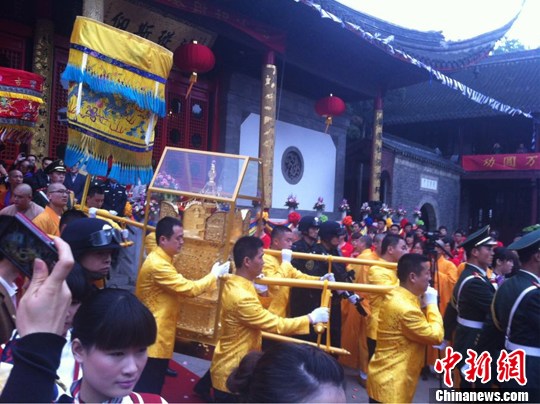Sakyamuni's remains arrive in HK for worship
 0 Comment(s)
0 Comment(s) Print
Print E-mail Xinhua, April 25, 2012
E-mail Xinhua, April 25, 2012
|
|
|
The parietal bone of Sakyamuni, encased in a glass cabinet, is carried by staff away from Xixia Temple in Nanjing. The remains will be displayed in Hong Kong for worship from April 25 to 30. [Chinanews] |
A rare piece of the parietal bone of Sakyamuni, the founder of Buddhism, was flown to Hong Kong from east China's Jiangsu province on Wednesday for public worship.
The Buddha's remains, or sarira, left the Lukou Airport in the provincial capital of Nanjing by a chartered plane at 12:30 p.m., marking the first time the sacred remains will be worshipped outside the Chinese mainland since being unearthed in June 2010 in Nanjing.
On Wednesday morning, a grand ceremony was held in Nanjing's Qixia Temple, where the remains had been enshrined prior to being flown to Hong Kong. Over 1,000 people attended the ceremony, including eminent Buddhist monks from the mainland, Hong Kong and Macao.
The remains are scheduled to be enshrined in the Hong Kong Coliseum from April 25 to 30, and will then be sent to the Macao East Asian Games Dome for public worship until May 4.
The remains will be placed in a custom-built pagoda that took 36 craftsmen 186 days to build. The pagoda will be housed in a bulletproof glass cabinet during the public worship period.
The worship event is being jointly hosted by the Buddhist Association of China, the Hong Kong Buddhist Association, an organizing committee in Macao and the Buddhist Association of Jiangsu.
During a 10-day tour in Hong Kong and Macao, organizers will hold a series of ceremonies in accordance with Buddhist customs, according to Ven. Hong Ming, executive vice president of the Hong Kong Buddhist Association.
Hong said a "grand activity" will be held to celebrate the birthday of Sakyamuni, which falls on April 28 this year.
The Buddhist Association of China will send a team to protect the remains during their travels.
The third World Buddhist Forum will be held in Hong Kong from Wednesday to Friday, marking the largest international Buddhist conference ever held in the region.
Monks and scholars from more than 50 countries and regions will attend the event to discuss the propagation of Dharma teachings and the protection of Buddhist scriptures, as well as exchange ideas on the development of Buddhist education and the promotion of Buddhist charitable efforts.
The 11th Panchen Lama Bainqen Erdini Qoigyijabu has accepted an invitation to attend the forum.
When unearthed, the parietal bone, allegedly recovered from the cremation ashes of Sakyamuni, was found to be stored in a miniature pagoda in an underground shrine built in 1011 under the former Changgan Temple in Nanjing.
It is said that 2,500 years ago, Sakyamuni's disciples recovered one parietal bone, four teeth and two collar bones from the cremation ashes of Sakyamuni.
King Asoka (273 BC - 232 BC), an Indian ruler who allegedly collected some of Sakyamuni's remains, stored them in pagoda-like shrines and sent them to different parts of the world.
The pagoda in Nanjing is believed to be one of tens of thousands of "King Asoka's pagodas" that contain Sakyamuni's remains. According to ancient Buddhist records, China was once home to 19 of the pagodas, seven of which are believed to have been discovered thus far.







Go to Forum >>0 Comment(s)